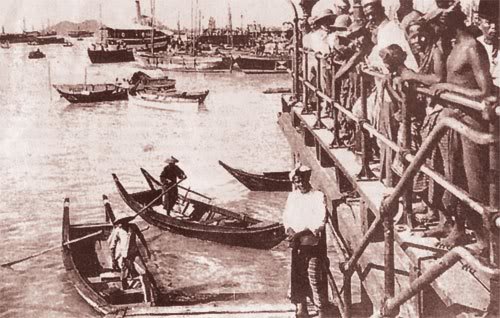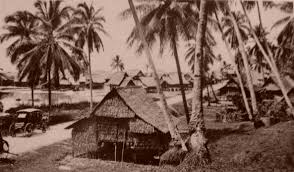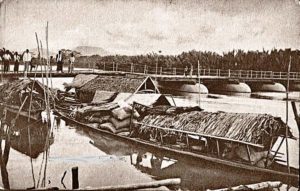
The History of Penang
Penang was previously part of the sultanate of Kedah until it became a British possession in 1786. It later became part of the Federation of Malaya in 1957.
The earliest name of Penang “Ping-lang-yu” (Island of Betel nut, Areca or Pinang) can be found in the reproduced chart based on Zheng He’s (or Cheng Ho) voyages in a printed work entitled Wubei Zhi (Treatise on Military Preparations) compiled by Mao Yuanji about 1621. [Ref: “The Chart of Zheng He Grand Voyages Maritimes” was being used during 1405-1433, maps and information were collected before each of Zheng’s voyages.]
16th-century Portuguese traders from Goa, India sailing to the Far East in search of spices found a small island where they replenished their water supplies. They called it Pulo Pinaom. In the 17th century, Penang’s location at the northern entry to theStraits of Malacca provided a sheltered harbour for Chinese, Indian, Arabian and European ships during the monsoon months; this, in turn, inevitably made it fertile hunting ground for pirates.
One of the very first Englishmen to reach Penang was the merchant-navigator Sir James Lancaster who in 1588 served under SirFrancis Drake as commander of the Edward Bonadventure against the nemesis of the Spanish Armada. On 10 April 1591, commanding the same ship, he set sail from Plymouth for the East Indies, reaching Penang in June 1592, remaining on the island until September of the same year and pillaging every vessel he encountered. He returned to England in May 1594.
Originally part of the Malay sultanate of Kedah, Penang was ceded to the British East India Company in 1786 by the Sultan of Kedah, Sultan Abdullah Mukarram Shah, in exchange for military protection from Siamese and Burmese armies who were threatening Kedah. On 11 August 1786, Captain Francis Light, known as the founder of Penang, hoisted the Union Jack thereby taking formal possession of Penang and renamed it Prince of Wales Island (name used until after 1867) in honour of the heir to the British throne. Penang was the first British possession in the Malay States and Southeast Asia.
The location of the island at the opening of the Straits of Malacca attracted the British East India Company to use the island as a natural harbour and anchorage for their trading ships, and as a naval base to counter growing French ambitions in the region. The settlement on the north-eastern tip of the island was named George Town after King George III of the United Kingdom.
Unbeknownst to the Sultan, Light had acted without the approval of the East India Company when he promised military protection. When the Company failed to aid Kedah when it was attacked bySiam (which renamed Penang Island “Koh Mak”), the Sultan tried to retake the island in 1790. The attempt was unsuccessful, and the Sultan was forced to cede the island to the Company for an honorarium of 6,000 Spanish dollars per annum. This was later increased to 10,000 dollars, with Province Wellesley (Seberang Prai) being added to Penang in 1800. An annual honorarium of 18,800 ringgit continues to be paid by the Penang State Government to the Sultan of Kedah.
The settlement was first built around the harbour with Fort Cornwallis forming the island’s defence. Light became the first Superintendent of the Prince of Wales Island. To expedite jungle clearing by labourers, Light fired silver coins from his ship cannons into the dense vegetation, and the land was cleared in no time. The original four streets of George Town were Beach Street, Light Street, Pitt Street (now Masjid Kapitan Keling Street) and Chulia Street, all of which still form the main thoroughfares of the modern city. Other early roads include Church Street, Bishop Street, China Street and Market Street, and by the early 19th century also Armenian Street and Acheen Street.
Light declared Prince of Wales Island a free port to attract trade away from the Dutch who were then the colonial rulers of the Dutch East Indies. This strategy drew many immigrant traders to Penang. Settlers were allowed to claim whatever land they could clear. By 1789, Penang had 5,000 residents and this doubled by the end of the following decade. The first Chinese settlers in Penang came from an existing community in Kedah, with their leader, called a Kapitan Cina, being Koh Lay Huan, a Baba.
Light died of malaria on 21 October 1794 and was buried at the Protestant cemetery at the end of Northam Road (now Jalan Sultan Ahmad Shah). His son, William Light went on to found the city of Adelaide in Australia. Lieutenant-Colonel Arthur Wellesley (the future Duke of Wellington) arrived in Penang to coordinate the island’s defences. In 1800,Lieutenant-Governor Sir George Leith secured a strip of land across the channel from the island and named it Province Wellesley, after Richard Colley Wellesley, 1st Marquess Wellesley, Governor-General of India
Early in the 19th century, Penang was used as a staging post for the opium trade between India and China. The East India Company auctioned off licences to gambling dens,brothels and opium traders (this alone accounted for approximately 60% of colonial Penang’s crimes)
In 1805, Penang’s colonial status was elevated to that of a Residency. Stamford Raffles arrived in Penang to work as the Deputy Secretary to the Governor of Penang, Philip Dundas from 1805 to 1810. and subsequently founded Singapore in 1819. John Crawfurd had earlier resided on the island for three years and, while embarked on a mission to the courts of Siam and Cochin China, moored there from 11 December until 5 January 1822. He found the settlement in a state of alarm, after an invasion of the territory of the King of Queda (Kedah) by the Raja of Ligor (Nakhon Si Thammarat.) As this had a direct impact on his mission, his account goes into considerable detail about the state of the island, including a census of the population by land of origin and the total in revenues contributed by each group. He also criticises British administration policy on licences and taxation, both on the island and on the Continent.


